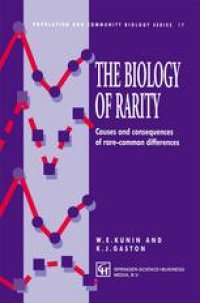
Ebook: The Biology of Rarity: Causes and consequences of rare—common differences
- Tags: Evolutionary Biology, Ecology, Nature Conservation
- Series: Population and Community Biology Series 17
- Year: 1997
- Publisher: Springer Netherlands
- Edition: 1
- Language: English
- pdf
This book began life as a review article. That article spawned a symposium which was, in turn, greatly expanded to form the present volume. As the project moved through these developmental stages (hopefully, towards attainment of its full maturity), a number of people have provided invaluable assistance to us, and we would like to take this opportunity to thank them. Gordon Orians must certainly take a high place in that list. He has been both a friend and mentor to W.E.K., and many of the topics explored in this book have emerged from the resultant dialogue. His thought processes, ideas and perhaps even some of his turns of phrase emerge throughout much ofthe book. Gordon also played a pivotal role in inviting in motion, and so he has served as a catalyst the article that set this project to the book as well as one of its reagents. While he has not served as an editor of this book, he is one of its authors in more than just the literal sense.
The study of rare species has long fascinated biologists. Rare and common species may differ in body size, dispersal, reproduction and many other respects. The Biology of Rarity reviews documented patterns of such differences, and considers the methodological difficulties plaguing their interpretation. This book provides an unusually wide ranging picture of how patterns of species differences can be maintained.
The authors consider the potential roles of community assembly rules and speciation in biasing the set of species that become rare, of extinction in `editing' that set, and the potential for changes in ecology, genetics and evolution to transform the characteristics of rare species over time. The potential role of phylogenetic comparisons in disentangling these processes is considered, along with potential applications to conservation biology.
The study of rare species has long fascinated biologists. Rare and common species may differ in body size, dispersal, reproduction and many other respects. The Biology of Rarity reviews documented patterns of such differences, and considers the methodological difficulties plaguing their interpretation. This book provides an unusually wide ranging picture of how patterns of species differences can be maintained.
The authors consider the potential roles of community assembly rules and speciation in biasing the set of species that become rare, of extinction in `editing' that set, and the potential for changes in ecology, genetics and evolution to transform the characteristics of rare species over time. The potential role of phylogenetic comparisons in disentangling these processes is considered, along with potential applications to conservation biology.
Content:
Front Matter....Pages i-xiv
Front Matter....Pages 1-1
Introduction: on the causes and consequences of rare—common differences....Pages 3-11
Rare—common differences: an overview....Pages 12-29
What is rarity?....Pages 30-47
Who is rare? Artefacts and complexities of rarity determination....Pages 48-60
Front Matter....Pages 61-61
Who gets the short bits of the broken stick?....Pages 63-90
Speciation and rarity: separating cause from consequence....Pages 91-109
How do rare species avoid extinction? A paleontological view....Pages 110-129
Extinction risk and rarity on an ecological timescale....Pages 130-149
Population biology and rarity: on the complexity of density dependence in insect—plant interactions....Pages 150-173
Genetic consequences of different patterns of distribution and abundance....Pages 174-189
Evolved consequences of rarity....Pages 190-208
Rarity and evolution: some theoretical considerations....Pages 209-234
Front Matter....Pages 235-235
Predicting and understanding rarity: the comparative approach....Pages 237-261
Concluding comments....Pages 262-272
Back Matter....Pages 273-280
The study of rare species has long fascinated biologists. Rare and common species may differ in body size, dispersal, reproduction and many other respects. The Biology of Rarity reviews documented patterns of such differences, and considers the methodological difficulties plaguing their interpretation. This book provides an unusually wide ranging picture of how patterns of species differences can be maintained.
The authors consider the potential roles of community assembly rules and speciation in biasing the set of species that become rare, of extinction in `editing' that set, and the potential for changes in ecology, genetics and evolution to transform the characteristics of rare species over time. The potential role of phylogenetic comparisons in disentangling these processes is considered, along with potential applications to conservation biology.
Content:
Front Matter....Pages i-xiv
Front Matter....Pages 1-1
Introduction: on the causes and consequences of rare—common differences....Pages 3-11
Rare—common differences: an overview....Pages 12-29
What is rarity?....Pages 30-47
Who is rare? Artefacts and complexities of rarity determination....Pages 48-60
Front Matter....Pages 61-61
Who gets the short bits of the broken stick?....Pages 63-90
Speciation and rarity: separating cause from consequence....Pages 91-109
How do rare species avoid extinction? A paleontological view....Pages 110-129
Extinction risk and rarity on an ecological timescale....Pages 130-149
Population biology and rarity: on the complexity of density dependence in insect—plant interactions....Pages 150-173
Genetic consequences of different patterns of distribution and abundance....Pages 174-189
Evolved consequences of rarity....Pages 190-208
Rarity and evolution: some theoretical considerations....Pages 209-234
Front Matter....Pages 235-235
Predicting and understanding rarity: the comparative approach....Pages 237-261
Concluding comments....Pages 262-272
Back Matter....Pages 273-280
....